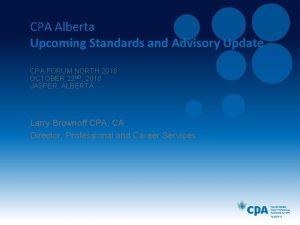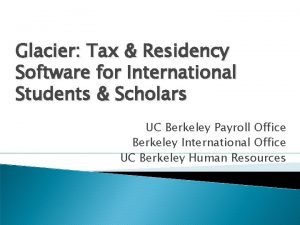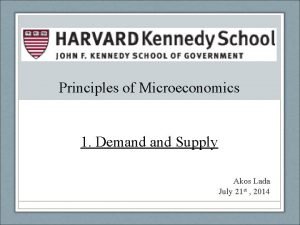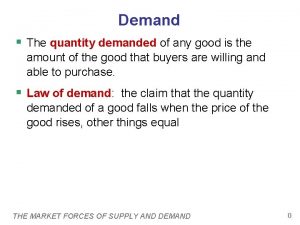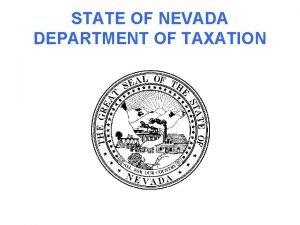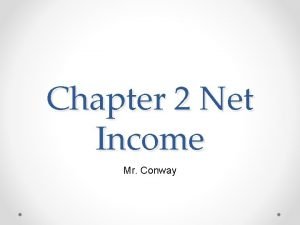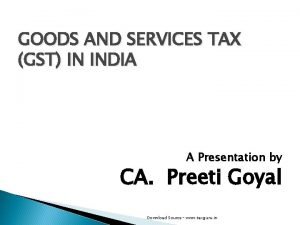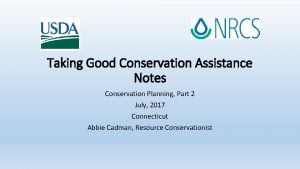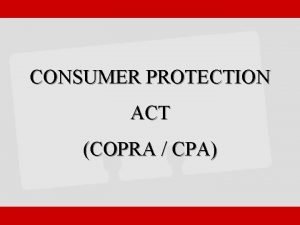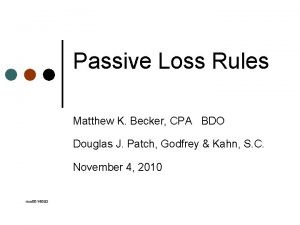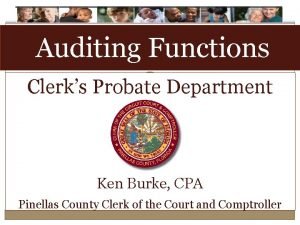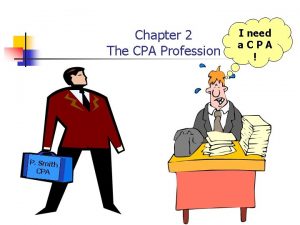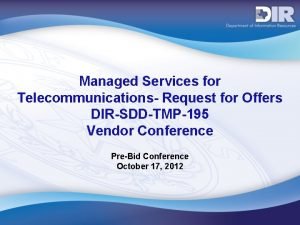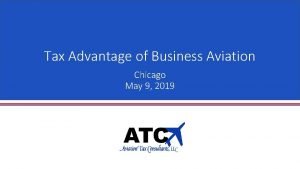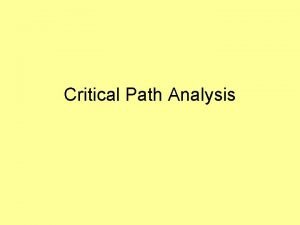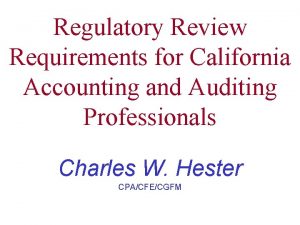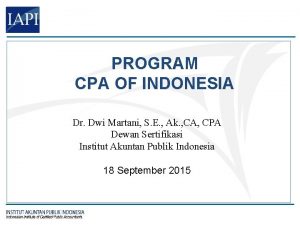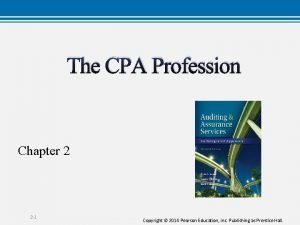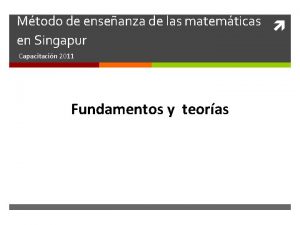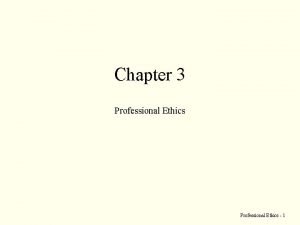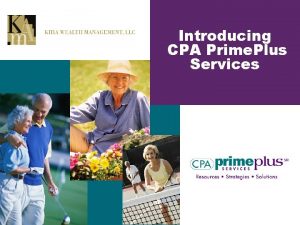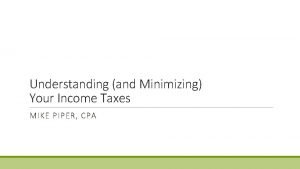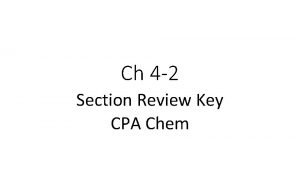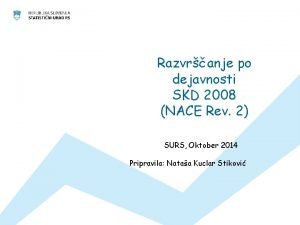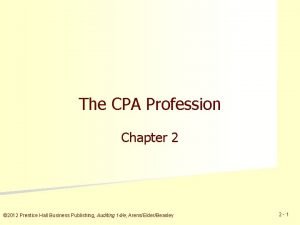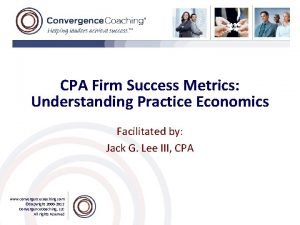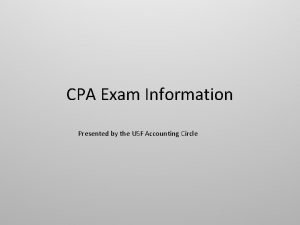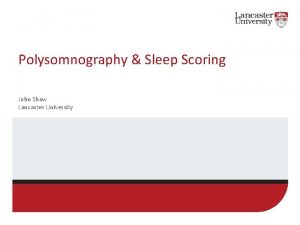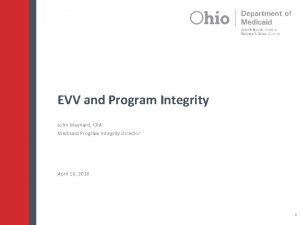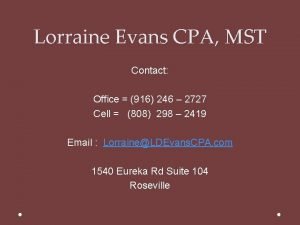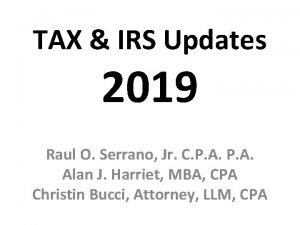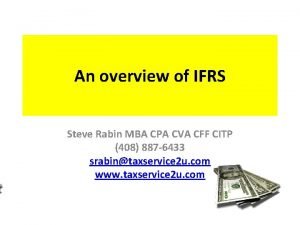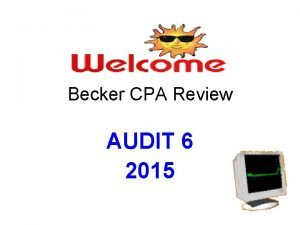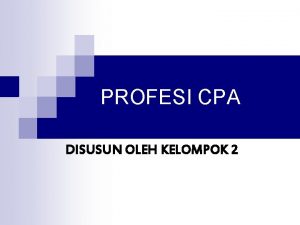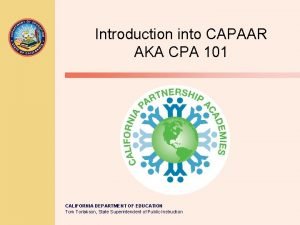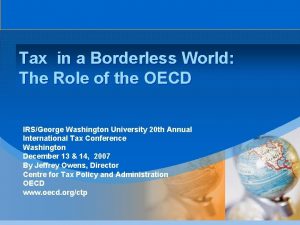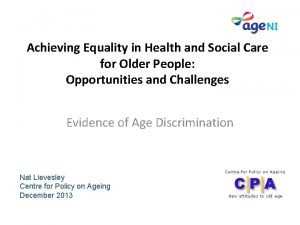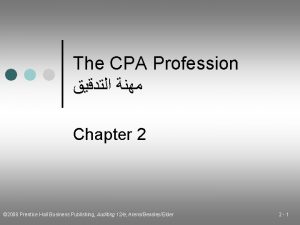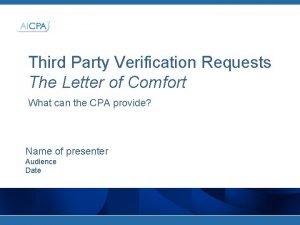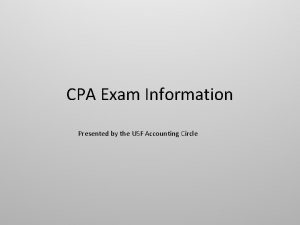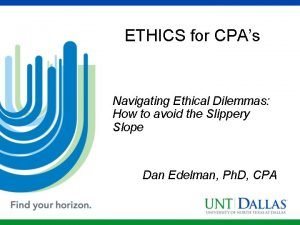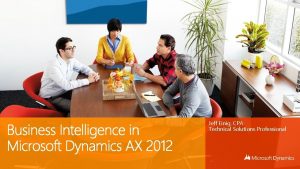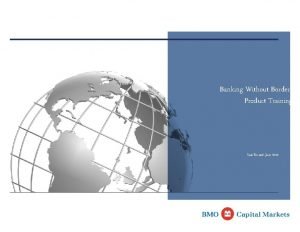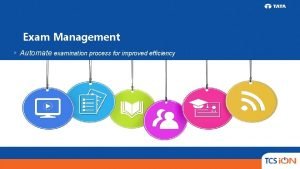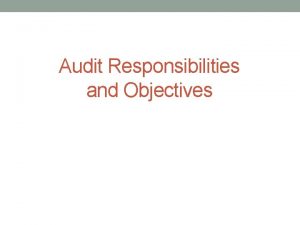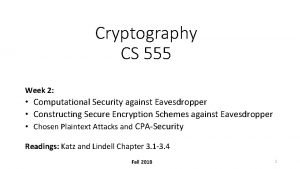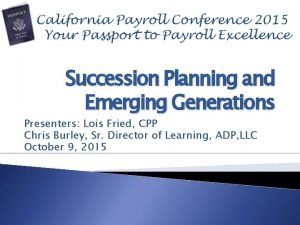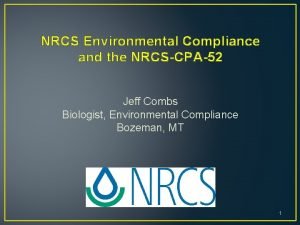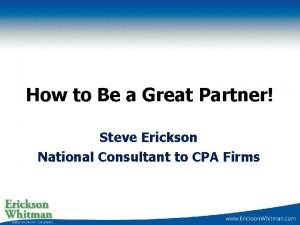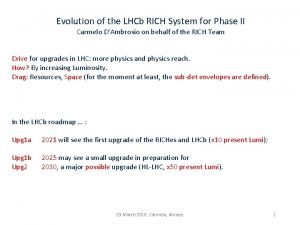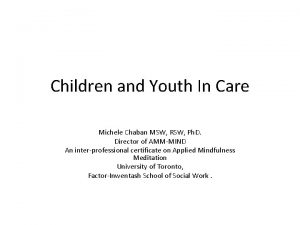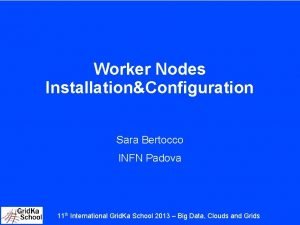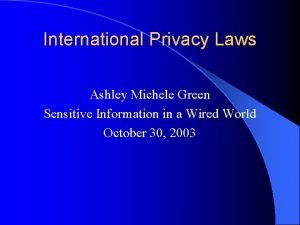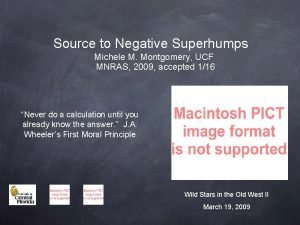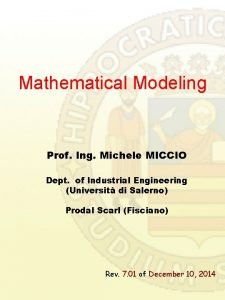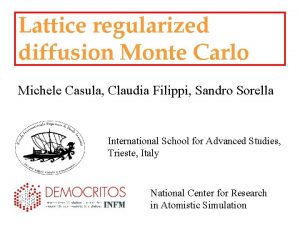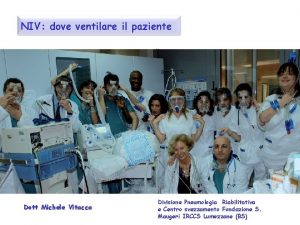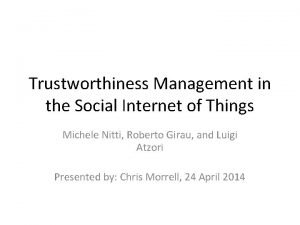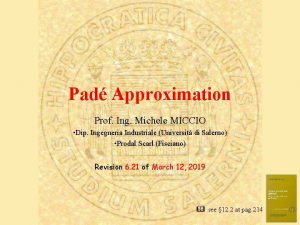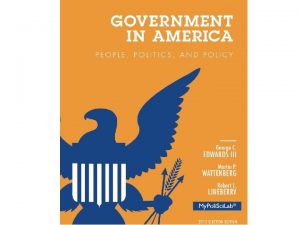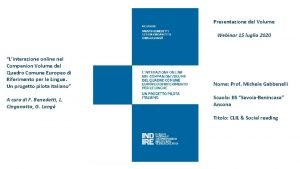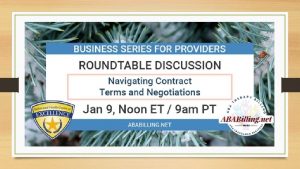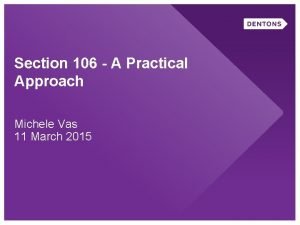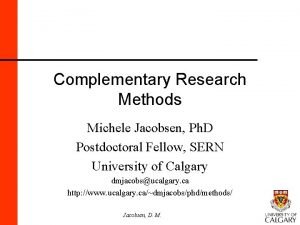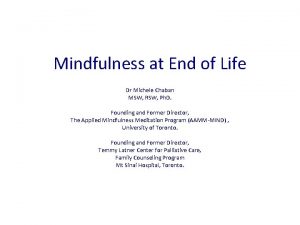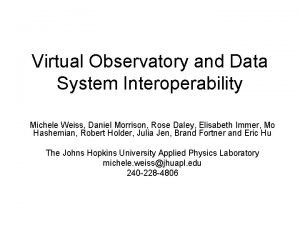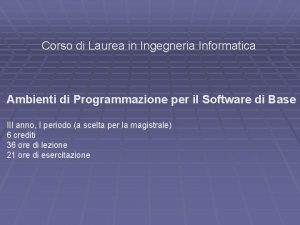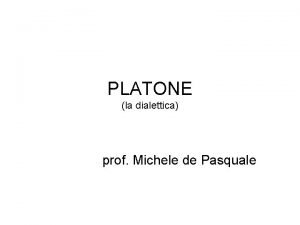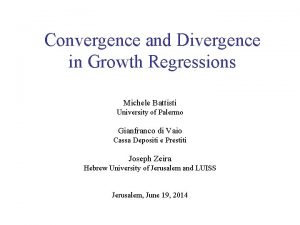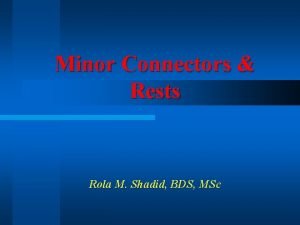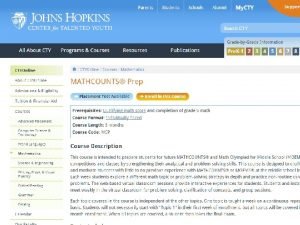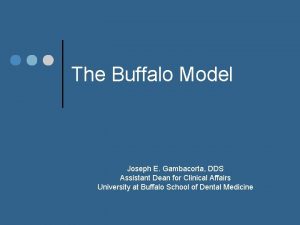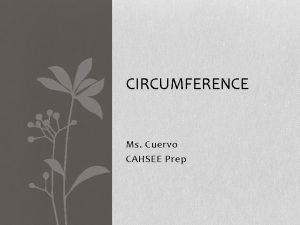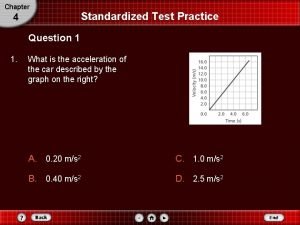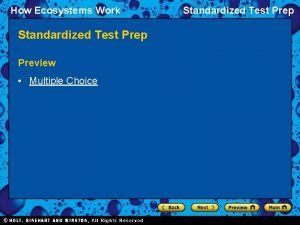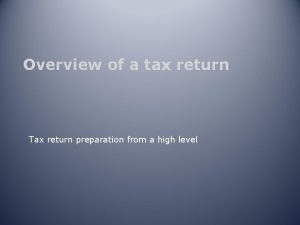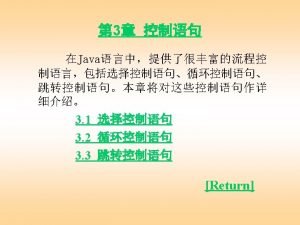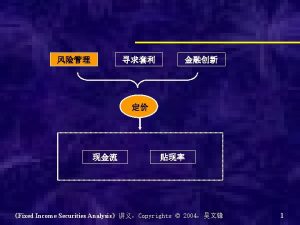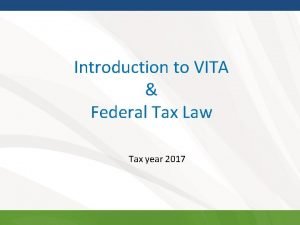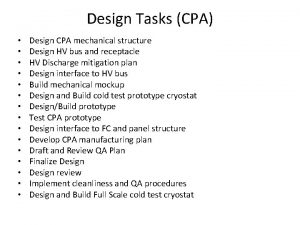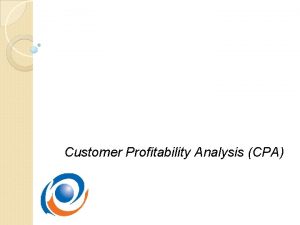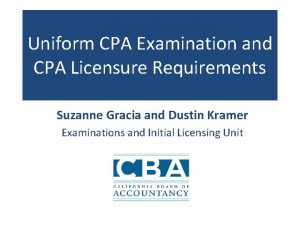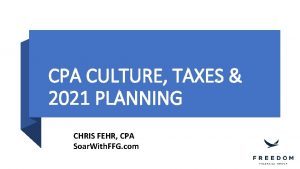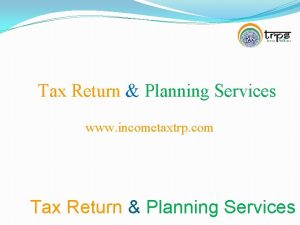VITA Tax Return Prep Michele D Meckfessel CPA


















































































































![Self Employment Tax Calculated on Schedule SE [automatically] Represents both the employee portion and Self Employment Tax Calculated on Schedule SE [automatically] Represents both the employee portion and](https://slidetodoc.com/presentation_image/ecf1dc23aec946f5234a28f8c753b40f/image-115.jpg)


















































- Slides: 165

VITA Tax Return Prep Michele D. Meckfessel, CPA, Ph. D

Welcome! Please sign-in and make sure you have picked up a packet containing the training materials. There a number of training materials inside the packet for you to use throughout training. Please bring these materials back on the second day of training. Snacks and drinks are available throughout the day, please help yourself. 2

WELCOME I WANT TO START WITH A THANK YOU Volunteers are the heart of this program. We could not do this work without you!

2018 RESULTS 532 volunteers We filed 8, 842 federal returns last year, bringing $9. 1 million in refunds to our community. All at no cost to our clients!! We saved our clients an estimated $2. 6 million in preparation fees.

Agenda Review of Volunteer Conduct, Roles and Responsibilities Intake Review 1040 Overview Review Tax Code 5

VITA/TCE Programs, you must: 1. Follow the Quality Site Requirements (QSR) 2. Not accept payment or solicit donations for federal or state tax return preparation 3. Not solicit business from taxpayers you assist or use the knowledge you gained (their information) about them for any direct or indirect personal benefit for you or any other specific individual 4. Not knowingly prepare false returns 5. Not engage in criminal, infamous, dishonest, notoriously disgraceful conduct, or any other conduct deemed to have a negative effect on the VITA/TCE Programs 6. Treat all taxpayers in a professional, courteous, and respectful manner 6

Volunteer Protection Act of 1997 Volunteers are exempt from liability if they are acting within the scope of their training and certification and they were not acting in gross negligence or willful misconduct. 7

Examinations Standards of Conduct-Ethics Intake/Interview and Quality Review Training Advanced Exam Basic Exam-only if you fail Advanced H. S. A. Must pass with 80% to be a volunteer 8

Roles and Responsibilities Greeters Tax Preparers* Quality Reviewers* Site Coordinators* *Require advanced certification. 9

Clients Must Have Government issued ID or driver’s license. Social Security card for each person listed on the return. Birth dates of all persons on the return. All tax documents -W 2 s, 1099 s, 1098, 1095 A, etc. Do NOT do the return if a document, such as a W-2 is missing. Bank routing/account numbers for direct deposit. 10

13614 -C Intake Form The use of 13614 -C is a MUST! It will help you identify the types of forms the taxpayer should have. It helps you identify the difficulty of the tax return you will be preparing. Review the intake form with the taxpayer. Discuss with them areas they marked unsure and decide whether they qualify and then select the appropriate answer. 11

INTAKE & INTERVIEW, QUALITY REVIEW A must for an accurate tax return

Who Must File?

Who Must File? Charts are provided to help you determine who must file: See Pub 4012, Who Must File tab The following summarizes Chart A, on page A-1: If Gross Income > Standard Deduction + Age or Blind Exemption then file a return. (e. g. single = $12, 000 +1, 600 for 65 or older or blind) Multiple other factors are involved that could require a person to file: See Charts C and D Anyone who had tax withholdings Received a Health Care Premium Credit Self-employment greater than $400 14

Becky’s Filing Requirement Becky is 29 years old and single Her gross income from her W-2 for the 2018 tax year is $13, 550 1. ) Based only on this information, is Becky required to file a tax return? 2. ) Why or why not? 15

Robert and Erica are married and usually file a joint return. During the tax year, Robert turned 66 and Erica turned 64. Their gross income was $24, 200. Based only on this information: 1. ) Are Robert and Erica required to file a return? 2. ) Why or why not? 16

Who Should File? Taxpayers below the filing requirements should file: To claim refund of withheld taxes To claim the Earned Income Credit To claim the Additional Child Tax Credit, or the American Opportunity Credit See Publication 4012 page A-3 for other reasons 17

Taxpayer Identification Numbers: Social Security Number (SSN) Individual Taxpayer Identification Number (ITIN) start with 9’s Adoption Taxpayer Identification Number (ATIN) Most green card holders have valid social security numbers and must follow the same tax laws as U. S. citizens, including the requirement to report worldwide income on their tax returns. Exception: Health Insurance is not required for non-US citizens nor for undocumented immigrants GECC tax preparation sites will file returns for those taxpayers determined to be resident aliens with ONLY U. S. INCOME 18

Filing Status and Filing Requirements 19

The NEW Form 1040 Filing Status 20

Filing Status Single Married Filing Jointly Married Filing Separately Head of Household Qualifying Widow(er) Refer to B-6 Decision Tree Chart in Publication 4012 21

Why is the filing status so important? It determines your standard deduction and tax brackets. The larger your standard deduction is, the lower your taxable income is, and thus the lower your total tax will be. Filing Status Single Married Filing Jointly / Qualifying Widower Head of Household Married Filing Separately Standard Deduction 2018 12, 000 24, 000 18, 000 12, 000 22 (and limits the ability to

Single Taxpayers can use the Single filing status if on December 31 they are: • Not married • Legally separated or divorced, or • Widowed before the beginning of the tax year and did not remarry IMPORTANT: Some taxpayers considered single can also file under a more advantageous status (Ho. H or QW). 23

Married Filing Jointly Status can be claimed by taxpayers who, on the last day of the tax year: Were legally married and lived together This includes same sex marriage Were married and living apart, but were not legally separated or divorced Lived together in a common law marriage that is recognized in the state where they currently live or the state where the common law marriage began, or Did not remarry after their spouse died during the year 24

Married Filing Separately Married taxpayers can also file separately; HOWEVER, MFS may NOT provide the benefit that many expect, and clients will ALMOST ALWAYS end up paying more in tax than if they filed jointly. There a number of severe restrictions on deductions and credits, and on the amount of IRA contributions that you can deduct, especially if you live together with your spouse. Cannot take the EIC, The child tax credit is phased out at a lower income level than any other filing status. Cannot take/limits on the credit for Child and Dependent Care, Cannot take the Education credits/deductions. If either of you receive Social Security benefits and you live with your spouse, more of the SS benefit will be taxable, and the person receiving it will have to include the SS benefit in their gross income when determining whether they have to file. 25

Why Do Some Choose MFS? Sometimes MFS is chosen when one spouse does not want to be responsible for the other spouse’s tax obligations or filing separately may result in a lower total tax (this is rare) Sometimes to avoid an offset of their refund against their spouse’s outstanding debts (child support, student loans, etc. ) Note: Even in these circumstances, there may be other options that allow them to file jointly and not be responsible for these debts (Injured Spouse Form) 26

Why Do Some Choose MFS? Note: Sometimes taxpayers must file separately because they are separated and not in communication with their spouse and don’t have the option of filing jointly 27

Death of a Spouse If a spouse died during the tax year, and the taxpayer did not remarry, they are considered married for the entire year. The surviving spouse is eligible to file as MFJ or MFS (generally want MFJ unless extenuating circumstances). If surviving spouse files MFJ with deceased spouse in year of death, and has a child or stepchild for whom they claim as a dependent AND paid more than half the cost of keeping up the home, AND they have not remarried, then they can file as qualifying widower for the two years following the spouses death. Surviving spouses that remarry must file with the new spouse, as MFJ or MFS. The deceased spouse’s filing status becomes MFS. 28

Qualifying Widow(er) To qualify: A spouse that died in 2016 or 2017 Filed MFJ in the year of death (2016 or 2017) You paid more than ½ the cost of keeping up your home Have a child/stepchild who live in your home all year and who would qualify as your dependent. A Foster Child or Grandchild does not qualify. 29

Jane’s Situation Jane’s husband died in 2018. She and her husband qualified to file a joint return in 2017, but they did not. Jane’s children are grown and maintain homes of their own. She has not remarried. 1) What filing statuses is Jane allowed to use on 2018’s tax return? 2) What filing status would be most beneficial to Jane? 30

Head of Household Two ways to qualify for HOH: 1. Unmarried and paid more than half the cost of keeping up a home for themselves and a dependent RELATIVE – must be related. 2. Married and paid more than half the cost of keeping up a home for themselves and a dependent CHILD, but spouse did not live in the same home the last six months of the year. 31

When can a legally married person file as Head of Household? Paid more than half the cost of keeping up your home for the year Spouse did not live in your home during the last 6 months of the tax year Home was the main home of your child, stepchild or foster child for more than half of the year. (A grandchild doesn’t meet this test). 32

For unmarried: Who is a qualifying person for Head of Household status? A qualifying person is defined as: A qualifying child who lived with you more than half the year and meets certain other tests A qualifying relative who is your father or mother A qualifying relative other than your father or mother who meets certain tests Must be RELATED to be Qualifying Person Refer to chart B-7 [4012 tab B. Filing Status] 33

Mary’s younger brother, Sebastian, is 17 and lived with some friends the entire months of January and February of the tax year. From March to July, he lived with Mary. On August 1, Sebastian moved back in with his friends, with whom he stayed for the rest of the year. Since Sebastian did not have a job, Mary gave him money every month for support. She has no other dependents. 1. ) Can Mary claim Head of Household Status? 34

Amy’s Case Amy has been separated from her husband since March of the tax year and her divorce is pending. She has sole custody of her three children, who lived with her the entire year. The children are all under the age of 19. She provided all of the cost of maintaining the home. 1) What filing statuses would Amy be allowed to use on her return? 2) What filing status would be most advantageous? 35

Who is a Dependent? 36

Qualifying Child Tests Misleading term – includes taxpayer’s brother or sister as well as child or descendent of any of these (i. e. grandchild, niece/nephew, etc. ) 1. Child must be less than 19 years old OR full time student (for at least 5 months) and less than 24 years old OR permanently and totally disabled. *Must also always be younger than taxpayers. 2. Child must reside with taxpayer for over half of the year (see temporary absences). 3. Child cannot provide over half of his/her own support. 4. Citizen Test – Must be resident of U. S. , Mexico, or Canada 5. Joint Return Test – If dependent is filing MFJ with spouse, 37

Qualifying Relative Tests Misleading term –dependent can be unrelated to taxpayer BUT must reside in taxpayers home for entire year if unrelated. 1. Taxpayer must provide over half of dependents support. 2. Dependent’s gross income cannot exceed $4, 150. 3. Residency test – must live with taxpayer if unrelated. 4. Citizen Test – Must be resident of U. S. , Mexico, or Canada 5. Joint Return Test – If dependent is filing MFJ with 38

Note: Taxpayers with ITIN Cards Remember: Taxpayers receive an ITIN if they are nonresidents but need to file a tax return and cannot obtain a SSN If a taxpayer lived in the United States all year and has an ITIN card, they will be considered a resident alien for tax purposes A “child” passes the citizenship test in this situation 39

“Permanently and Totally Disabled” A person is considered permanently and totally disabled if he or she cannot engage in any substantial gainful activity because of a physical or mental condition, AND A doctor determines the condition has lasted or can be expected to last continuously for at least a year or can lead to death 40

“Temporary Absences” A child is considered to have lived with you during periods of time when one of you, or both are temporarily absent due to illness, education, business, vacation, military service, or detention in a juvenile facility 41

Exercise Rebecca is unmarried with one child, Colin is 8 years old and lives full time with his mother, who provides all of his support. He is a U. S. citizen, and no other adults live in their household. Can Rebecca claim Colin as a dependent? Use the Publication 4012, chart C-1 42

Exercise – Answer YES Colin meets all the requirements to be claimed as a qualifying child. 43

Exercise Paul is a U. S. citizen who is 26 years old, permanently disabled, unmarried, did not pay for more than half of his support and lived with his parents for the entire year. Can Paul be claimed as a dependent by his parents? 44

Exercise – Answer YES. Paul meets all the requirements to be claimed as a qualifying child. 45

Exercise Roderick, age 29, lives with his uncle. Last year, he worked part-time and earned $2, 100. His uncle provided for the rest of his support, including rent and household costs. Can his uncle claim Roderick as a dependent? 46

Exercise – Answer YES. His uncle can claim Roderick as a qualifying relative. He is too old to be a qualifying child, but he earns less than $4, 150, lived with his uncle more than 6 months of the year, and his uncle provided more than half of his personal support. 47

Exercise Gina Brown provides all support for her uncle. Uncle Jim is unmarried, 72 years old, and lives in another city. He has no gross income for the calendar year. Can Gina claim Uncle Jim as a dependent? 48

Exercise - Answer YES. Jim meets all of the requirements to be a qualifying relative of Gina. 49

Tim and His Parents Tim, 23, was a full-time college student who lived with his parents all of 2018. His parents provided all of the cost of keeping up a home Tim earned $4, 200 and put it in a savings account. All three have valid Social Security numbers. 1. ) Can Tim be claimed as a dependent by his parents? 2. ) Is Tim required to file a return? 3. ) Should Tim file a return? 50

Qualifying Child of More Than One Person Sometimes, a child meets all of the tests to be claimed by more than one taxpayer. Example: a mother and a grandmother oran unmarried or divorced mother and father. Parenthood and AGI should then be taken into consideration in determining who is eligible to claim the child. See Publication 4012 – Chart on C-2 51

Add these questions to 4012, page C-3, under Step 9 Did any other adult live in your home? What was that other adult’s relationship to the child? Could the other adult be claimed as a dependent by someone else? These will assist you in determining if a 52

So who claims the child when more than one taxpayer can? Only one taxpayer can claim the child as a qualifying child for all tax benefits: Head of Household Child Tax Credit * Earned Income Credit * Dependent Care Credit * UNLESS! The special rule for children of divorced or separated parents applies. The above credits are split as follows: *The non-custodial parent gets to claim the child as a dependent for the Child Tax Credit [$2000 credit] *The custodial parent should enter the child as a nondependent for the EITC, Child & Dependent Care Credits, and HOH filing status. BENEFITS CANNOT BE DIVIDED BETWEEN TWO TAXPAYERS WHO ARE NOT THE CHILD’S PARENTS 53

What if the parents live apart? The custodial parent generally claims the dependent child and receives all associated tax benefits. The noncustodial parent can claim the dependent child if the parents have signed an agreement Form 8332 (REQUIRED for post-2008 divorce) Or the divorce decree falls under one of the conditions in Table 3 C-6 of Pub. 4012 � The noncustodial parent must attach a copy of the form or statement to his or her tax return. Can be e-filed using form 8459 – [Preparer needs to make a copy for our file and mark in the return that a form 8332 exists] 54

Ed and Larry Ed, 30, and his daughter, Rose, 9, lived with Ed’s brother, Larry, all of 2018. Ed is unmarried and has been out of work, with $3, 000 in unemployment benefits for 2018 Larry, age 28, provides all of the support for Ed and Rose. Larry’s 2018 salary was $19, 500 All three are U. S. citizens 1. ) Who is eligible to claim Rose? 2. ) Can Larry claim Ed? 3. ) What filing status should Larry use? 4. ) Who must file a return? 55

Joan and Mary Ann Since her husband died five years ago, Joan has lived with her friend Mary Ann, who is also a widow. Joan is a U. S. citizen, is single, and lived with Mary Ann the entire tax year. Joan had no income and received all of her support from Mary Ann. Joan cannot be claimed as a dependent on any one else’s return. 1) Can Mary Ann claim Joan as a Dependent? 2) What filing status will Mary. Ann use? 56

Income 57

Taxable Income Wages, salaries, commissions, tips Interest, dividends, pensions, capital gains Alimony, business income, hobby income Rents, royalties, partnership/S- Corporation, estate or trust income Unemployment benefits Jury duty pay, gambling winnings, cancellation of debt Some State tax refunds Other items of income unless they are designated as nontaxable See complete list in Publication 4012, Tab D-1 Income 58

Nontaxable Items Child support (not the same as alimony) Public assistance-food stamps Veteran’s disability benefits Federal income tax refunds Gifts and inheritances Municipal bond exempt interest Other items listed in D-1 of Pub 4012 59

Income on the NEW 1040 The new form only has five income categories: 1. Wages, salaries, tips, etc. 2. Interest 3. Dividends 4. Pensions, IRAs, Annuities 5. Social Security For all other types of income, you will need to see Schedule 1 60

Form 1040 Income This will benefit individuals who are employees with limited sources of income, few or no deductions, and overall very simple tax returns. For everyone else, it is slightly more complicated. Not having all of the info on one form can cause confusion for the taxpayer, and poor visibility of the whole picture for both the taxpayer and preparer. 61

Schedule 1 – Additional Income 62

State Tax Refund Taxpayers who receive a refund of state or local income taxes may receive Form 1099 -G listing their refund in box 2. NOT everyone must include their state tax refund as taxable income. Only if they itemized in the prior tax year. Now reported on Schedule 1 – Additional Income, Line 10 63

Form 1099 -G: Certain Government Payments 64

State Tax Refund Prior tax year (PTY) state tax refund may be taxable and need to be reported Conditions in which PTY state tax refund is taxable: • Received a refund on a state return • Itemized Deductions in PTY (Federal) AND • Deducted state income tax instead of state sales tax when itemizing deductions (Federal) 65

State Tax Refund What if taxpayer doesn’t know if they itemized deductions last year? • Ask: “Did you have any mortgage interest, medical expenses, charitable contributions, etc. , that you listed on your return last year? ” • A taxpayer may not be sure if they did, but often they are very confident that they did not have any of these deductions listed last year 66

PTY State Tax Refund If the taxpayer needs to report the state tax refund, go to: Federal Section Income State and local refunds Enter in the necessary information To correctly report a state tax refund amount, the following info from the PTY return is needed: State tax refund amount Sch A, line 5 a, state income taxes (TBD) Total itemized deductions amount Filing status 67

Form W 2 -G: Certain Gambling Winnings A taxpayer may receive one or more Form W 2 -Gs reporting gambling winnings Classified as unearned income Note: If a taxpayer has gambling winnings not reported on a Form W 2 -G, they must still be reported as income on the tax return 68

Earned Income Credit (EIC) 69

Earned Income Credit Refundable tax credit for low-to-moderate income workers to encourage work, offset payroll and income taxes, and help meet basic needs See Pub 4012 Tab I 70

Earned Income Credit: Maximum Credit Amounts 71

Earned Income Earned income is typically just that, money that is “earned” through employment. Wages and salaries Tip income Self employment income Used to determine the Earned Income 72 Credit see I-1 (EITC or EIC)

General Eligibility Rules For EITC Must file a tax return Must have earned income Must not exceed maximum income limits [See Publication 4012 Tab I-2] Must have valid SSN (ITINs not allowed) Must not use MFS filing status Must be a U. S. citizen or Resident 73

General Eligibility EITC cont’d. Must not file form 2555 (foreign income) Must not exceed investment income limit of $3, 500 for 2018 3, 500 Interest, dividends, capital gains, rental income, royalties, etc. Must not be a qualifying child of another taxpayer 74

EIC with a Qualifying Child: General Rules Must meet all three tests: § Relationship Test § Age Test –under 19 § Or under 24 if full time student § Or disabled [no age limit] § Residency Test Same tests for Qualifying Child Dependency Test – excluding the support test. See Pub 4012 Tab I-2 75

Qualifying Child Includes Eligible foster child Adopted child Permanently and totally disabled Child who was kidnapped Does NOT include cousins 76

Born or Died Rule A child born or who died at any time during the year is considered to have lived with you for 12 months. 77

Qualifying Child of More Than One Taxpayer for EIC Qualifying child can’t be used by more than one person to claim the EIC. If the parents were not married or if the child lives with parent and grandparent, or with both parents: �The tie-breaker rules apply. See I-5 in Pub 4012 78

EIC Without a Child § Earned income and AGI below $15, 270 ($20, 950 MFJ) 2018 limits [Publication 4012 pg I-2] § Lived in the United States more than half the tax year § At least 25 but under age 65 on Dec. 31 § If married filing jointly, only one spouse must be at least 25 or under 65. § Does not qualify as the dependent of another person 79

EIC – Other Information If EITC was denied in previous year Must file Form 8862 explaining why it was denied Can still be e-filed 80

EITC Determinations Determine for each of the following cases if the taxpayer would qualify to claim the EITC. Why or why not? 81

EITC Determinations Maureen’s 20 year old daughter lived with her for 8 months during the tax year. She is a full time college student who is not married. Maureen is 42 years old. Maureen earned $25, 000 from her job. 82

EITC Determinations Lisa is raising 3 children as if they were her own. Tara, 3, is the daughter of Lisa’s cousin. Paul is 2. Lisa adopted him from Europe and he began living with her in November of the tax year. Dwight, 20, is Lisa’s son. He attends community college part time. Which child, if any, qualify Lisa for EITC? 83

EITC Determinations Jane, 31, and Todd, 33, have never been married. They have one child together, Amanda, 8. Jane and Amanda lived in an apartment for the entire year. Todd lived alone. Jane earned $15, 000 as a clerk. Todd earned $48, 000 as a manager. Todd paid more than half of the living expenses for Jane and Amanda. All three are U. S. citizens with valid SSN’s. Who can claim the EITC and why? 84

EITC Determinations A married couple, Steve and Ellen, are filing jointly. They are raising their granddaughter, 10, because their daughter is serving a long prison term. They are also caring for an unrelated 8 -year-old boy who was placed with them as a foster child by the state. Both children lived with them the entire year. They have wages of $43, 560. Can they claim EITC on either child? What if they only had the granddaughter? 85

EITC Determinations Rob and Laura are divorced. Laura is the custodial parent for Dawn, who lived with her for the entire year. Laura signed form 8332, allowing Rob to claim the dependency exemption for Dawn until she turns 18. Can Rob claim Dawn for EITC? 86

Dependency and EIC Scenario Eric’s older sister, Jessica, lives with him and is permanently and totally disabled. Jessica received disability income which she used to provide more than half of her own support. Can Eric claim Jessica as a qualifying dependent child or a qualifying dependent relative? What credit does Jessica qualify Eric for? 87

When EIC has been disallowed For taxpayers whose earned income credit (EIC) was denied or reduced by the IRS, you may need to complete Form 8862, Information To Claim Certain Refundable Credits After Disallowance. Don't file Form 8862 if taxpayer filed Form 8862 in a later year and the EIC for that later year was allowed, and the EIC hasn't been reduced or disallowed again for any reason other than a math or clerical error. Don’t file Form 8862 if taxpayer is taking the EIC without a qualifying child for 2018 and the only reason the EIC was reduced or disallowed in the earlier year was because the IRS determined that a child listed on Schedule EIC wasn’t the taxpayers qualifying child Can’t claim the EIC for 2 years after there was a final determination that disallowance of EIC claim was due to reckless or intentional disregard of the EIC rules. Cant claim the EIC for 10 years if disallowance was due to fraud. 88

The client is getting a refund-now what? 89

Direct Deposit Can split the refund into up to three accounts Need routing and account number “Spend some, save some” Ask if the refund is > $500 90

SAVINGS IS A BIG PART OF TAX TIME Ask every taxpayer if they want to save part of their refund.

“ Would you like to save part of your refund today? Tax time is the perfect time to save for an emergency, a college savings account or another life dream you have.

U. S. Savings Bonds Taxpayers can buy U. S. Savings Bonds with refunds No need for bank account Can be purchased for anyone Purchased in $50 increments up to $5, 000 Bonds are mailed to client Interest rate of 2. 83% thru April 30, 2019 Use form 8888 93

SAVE SOME. SPEND SOME. Use Form 8888. 94

FINISHING THE RETURN o Make sure we have copies of all tax forms used in o o o preparing the return. Document anything that has been verbally obtained from the taxpayer that doesn’t have paper documentation. All returns must be Quality Reviewed Print returns (Federal and State) for taxpayer Review return with taxpayer Have taxpayer and Spouse sign 8879 for Federal. Remind them they are responsible for their return and by signing, they are agreeing it is accurate – 1 for the taxpayer, 1 for the VITA site

Income: Other Income, Business/Self. Employment 96

Form 1099 -MISC 97

Form 1099 -MISC: Other Income Reported in box 3 Other income reported in this box is generally: Prizes Awards Taxable damages (from a lawsuit settlement) Other taxable income Other income in box 3 is classified as unearned income 98

Form 1099 -MISC: Federal Income Tax Withheld Reported in box 4 Taxpayers can choose to have federal income tax withheld on other income in box 3 99

Form 1099 -MISC: Nonemployee Compensation If payment for services from a company or organization is reported in box 7 – “Nonemployee Compensation”, the taxpayer is being treated as a self-employed worker - aka independent contractor. Self-employment income, also known as business income, is taxed differently than wages/salary Independent contractors work for a company or organization without being considered an “employee” Freelancers, part-time workers, contractors, interns 100

Business/Self-Employment Income Why is it important to designate between wages and business/self-employment income? Federal income taxes are not withheld from business income FICA taxes are not withheld from business income However, the taxpayer must still pay federal income taxes and FICA taxes on business income! 101

Schedule C Income from a personal business (sole proprietor) or independent contractor (nonemployee compensation) is reported on schedule C. Business/self-employment income can be reported to taxpayers in a variety of ways. You may see the following tax documents that will be your source for entering business/self-employment income into Schedule C: 102

Form 1099 -MISC 103

Form W-2: Wage and Tax Statement See Your Site Coordinat or 104

Form 1099 -K, box 1 a 105

Business/Self-Employment Income Having a part-time business (even in addition to another job) may still be self-employment income and need to be reported Cash Payments: Income that was not reported on Form W-2, 1099 -MISC or 1099 -K still needs to be reported as cash payments. A taxpayer may have simply received cash payments for their work, and in this case, the taxpayer should keep records to track their income. 106

Example Andy works as an independent contractor for a painting company. He received a 1099 -MISC from the company that shows he made $10, 000. He also received $2, 000 in cash payments from a few different people for the work he completed, but he did not receive a 1099 -MISC for the $2, 000. What is Andy’s total business income that needs to be reported on Line 12 of schedule 1? 107

Example – Answer Andy must include the amounts from both the 1099 MISC and cash payments. His total business income that must be reported is $12, 000. 108

Business/Self-Employment Income vs. Other Income Business Income • An activity qualifies as a business if: The primary purpose for engaging in the activity is for income or profit The taxpayer is involved in the activity with continuity and regularity Other Income • A sporadic activity or a hobby does not qualify as a business • Hobby: undertaken for pleasure during leisure time (not for profit) 109

Business/Self-Employment Income Terms Business expenses: amounts that are ordinary and necessary to carry on the business Business expenses are subtracted from gross receipts to obtain the net profit/loss Net profit/Loss = Gross Receipts – Expenses Cash method of accounting: Reports all income when received and deducts all expenses when paid 110

Business/Self-Employment Income VITA Filing Conditions Less than $25, 000 of business expenses Cash method of accounting No inventory No returns or allowances No actual auto expenses (Standard Deduction auto only) Does not want to depreciate assets Must report a profit— no net loss! No employees 111

Business/Self-Employment Income: Schedule C or C-EZ Schedule C-EZ is just the simplified version of the Schedule C • Use the Schedule C-EZ if there are few business expenses and only one business ² Less than $5, 000 • Use the Schedule C if there a lot of business expenses and/or more than one business ² $5, 000 to $25, 000 TAXSLAYER MAKES THIS DECISION FOR YOU! 112

Business Expenses Advertising Car or truck mileage Repairs and maintenance Commissions and fees Supplies Insurance Taxes and licenses Other interest Travel Legal and professional 50% of business meals services and fees Office expenses Utilities (including telephone) Rent or lease expenses A separate Schedule C must be filed for each business (limit of 2) 113

Health Insurance Costs for the Self-Employed Taxpayer Health insurance paid by a self-employed taxpayer is not considered a “business expense. ” HOWEVER, you can enter the health insurance costs within the Schedule C worksheet in Tax. Slayer while you are entering in other business expenses. Tax. Slayer carries the health insurance entered into the Schedule C worksheet to the appropriate section of the tax return (i. e. a self employed person gets to deduct health insurance costs as an adjustment to income on Schedule 1). 114
![Self Employment Tax Calculated on Schedule SE automatically Represents both the employee portion and Self Employment Tax Calculated on Schedule SE [automatically] Represents both the employee portion and](https://slidetodoc.com/presentation_image/ecf1dc23aec946f5234a28f8c753b40f/image-115.jpg)
Self Employment Tax Calculated on Schedule SE [automatically] Represents both the employee portion and the employers portion Social Security tax rate for self-employment income for 15. 3% One half of the SE tax is deducted in the Adjustments Again, Tax. Slayer does this for you! section. What you need to know – People who are self-employed are going to owe (likely a large amount) of tax unless they made quarterly estimated tax payments. 115

Rogers Painting Co As a painting contractor, Roger had gross receipts of $4, 953 and supply expenses of $1, 675. His written mileage log shows he drove 1250 miles, 500 of them commuting and 750 business miles. He uses the standard mileage rate to determine his driving expenses. How much can Roger deduct for his total business expenses? 116

Self-employed taxpayers are eligible to file Schedule C (For VITA Returns) if they _____. A. Have a net loss B. Use the accrual method of accounting C. Incur $25, 000 or less in business expenses D. Have only one employee besides themselves 117

All of the following are deductible business expenses on Schedule C (For VITA Returns) EXCEPT _____. A. Interest paid on business loans B. Expenses for business use of the taxpayer's home C. Legal and professional services and fees D. Telephone bills 118

Investment Income Dividends Interest Income Capital Gains Distribution Sale of assets 119

Interest Income Note: Use Schedule B Interest Statement in Tax. Slayer 120

Basic Adjustments Early Withdrawal Penalties Input on Schedule B detail statement 121

Dividend Income Note: Use Schedule B Interest Statement in Tax. Slayer Dividends and capital gain distributions 122

Capital Gain Distributions are reported on Form 1099 DIV Capital Gains Distributions are entered on the Schedule B Dividend Statement Taxpayers who have received capital gain distributions only from mutual funds, and did not actually sell their shares of the mutual fund or any stock, generally do not need to use Schedule D Not the same as Capital Gains and Losses from sales of stocks or sale of home/property! These are not investment distributions and go on Sch. D 123

CAPITAL GAINS AND LOSSES 124

Capital Gains and Losses Sales of assets is reported to a taxpayer on a 1099 B Capital gains and losses are classified as long-term or short-term. If you hold the asset for less than one year before you dispose of it, your capital gain or loss is short-term If you hold the asset for more than one year before you dispose of it, your capital gain or loss is long-term You will enter information from the 1099 -B onto Schedule D. 125

Reporting To report a capital gain or loss on Form 1040, Schedule D you will need to identify from the 1099 -B: Basis (cost) or Adjusted Basis If basis not known the basis = $0 Holding period Proceeds from the sale: [sales price – cost] 126

Basis Other than Cost The basis of inherited property is generally the FMV of the property on the date of the decedent's death Inherited property is considered Long Term Basis of gifted stock is out of scope for VITA Other methods of valuation are available but are out of scope for VITA 127

How are Capital Gains/Losses taxed? Its complicated…. What you need to know: enter short term and long term transactions into Tax. Slayer correctly and it does the rest! The key is to appropriately identify items on the 1099 -B 128

complicated 129

Henry’s Transactions On May 11, 2004, Henry bought 100 shares of ZZZ Corporation stock for $1, 000 plus an additional $100 commission. What is Henry's original basis in the stock? On February 14, 2018, he sold 50 shares for $600 Is the holding period for the sold shares Short Term or Long Term? What is his gain or loss?

Retirement Income 131

Retirement Forms Retirement income can be reported on: • Form 1099 -R Distributions From Pensions, Annuities, Retirement or Profit-Sharing Plans, IRAs, Insurance Contracts, etc. • Form CSA 1099 -R Statement of Annuity Paid (civil service retirement payments) • Form CSF 1099 -R Statement of Survivor Annuity Paid • Form RRB 1099 R Annuities or Pensions by the Retirement Railroad Board 132

Form 1099 -R: Distributions From Pensions, Annuities, Retirement… Taxpayers who received income during the tax year from a retirement account (IRA, pension, etc. ) will receive a Form 1099 -R to report on their tax return Most taxpayers receive this after they retire, but some taxpayers may have made an early withdrawal from a retirement account 133

From Pensions, Annuities, Retirement… 134

Retirement Income: IRAs and PENSIONS Enter on Form 1099 -R in Tax. Slayer Gross Distribution Taxable Amount Boxes in line 2 b Taxable Amount Not Determined Total Distribution Federal Income Tax Withheld Distribution Code(s) Total Employee Contributions 135

Form 1099 -R: Taxable Amount Reported in box 2 a Shows the total amount that is subject to federal income tax The box MAY be blank and require additional computation to determine taxable amount 136

Form 1099 -R: Taxable Amount Not Determined & Total Distribution Reported in box 2 b ❒Taxable Amount Not Determined indicates that the payer was unable to determine the taxable amount— box 2 a should also be blank ❒Total Distribution indicates that the distribution was a total distribution that closed out the account 137

Form 1099 -R: Distribution Code(s) & IRA/SEP/SIMPLE Reported in box 7 Distribution Code(s) identify the type of distribution received Only certain distribution types are in scope for VITA 138

Form 1099 -R: Distribution Code(s) & IRA/SEP/SIMPLE 1: Early distribution, no known exception (in most cases, under age 59 ½) 2: Early distribution, exception applies (under age 59 ½) 3: Disability 4: Death 7: Normal distribution B: Designated Roth account distribution G: Direct rollover and rollover distribution See the Publication 4012, D-37 for a full list of box 7 distribution codes (and which are in 139 scope)

Form 1099 -R: Distribution Code(s) & IRA/SEP/SIMPLE ❒IRA/SEP/SIMPLE indicates that the distribution was from a traditional IRA, SEP, or SIMPLE retirement account ONLY traditional IRAs are in scope! Verify with the taxpayer that the amount distributed was from a traditional IRA 140

Form 1099 -R: Total Employee Contributions Reported in box 9 b For certain plans, an amount may be listed here showing the taxpayer’s contributions to the plan This amount is used to help determine the taxable amount if box 2 a is blank. 141

Form CSF 1099 -R: Statement of Survivor Annuity Paid Provides the same information as the Form 1099 -R Issued to survivors of civil service employees (if the employee elected to have a survivor annuity for spouse and/or children) 142

Individual or Joint/Survivor Annuities Must use the Simplified Method worksheet in Tax. Slayer to calculate the taxable portion of the annuity. What you will need to enter in the worksheet: ‘Cost of the pension” = Contributions made by employee If an employee contributed to their pension, the amount will be reported on 1099 -R in box 9 b Type of annuity (Individual or Joint/Survivor) Annuity start date (month and year) Age of taxpayer at start date Also combine age of spouse at start date if Joint/Survivor annuity Distributions received prior to start date 143

Rollover Refers to transferring the holdings in one retirement account to another Specifically, the retirement account is emptied and distributed to the owner, who then deposits them into a new account for reinvestment This is a TAX-FREE DISTRIBUTION But still must be reported on the federal tax return Code G will be in Box 7 of the 1099 -R 144

Disability Pension Income Why would a taxpayer have disability pension income? • Perhaps they had an accident that rendered them totally and permanently disabled Disability payments may be coming from a qualified retirement pension plan 145

Public and Military Pensions Public Pension Exemption May be eligible to deduct up to 100% of public retirement benefits received from PSRS or PEERS on the MO tax return as long as: Missouri AGI (excluding taxable social security benefits) must be less than $100, 000 if married filing combined or $85, 000 if single, head of household, married filing separate, or qualifying widower Partial credit available possibly if income is over Military Pension Exemption 100% of military pension income is tax free from Missouri tax 146

Cancellation of Credit Card Debt is reported to the taxpayer on a 1099 -C The cancellation amount is reported on Line 21 Schedule 1 “Other Income” The following situations are typically out of scope: Interest reported on 1099 -C Insolvent immediately before the cancellation of debt Cancellation of debt was related to a business 147

Form 1040 Adjustments Gross Income Now on Schedule 1 148

Total Income (Earned + Unearned) Adjusted Gross Income Adjustment s 149

Adjustments to Income Adjustments are basic life expenses that help decrease the amount of taxable income: Educator expenses Moving expenses (military only now!) Half of self-employment tax Self-employed health insurance Early withdrawal penalty Alimony paid (new rules!) IRA contributions (traditional) Student loan interest College tuition payments (maybe!) 150

Educator Expenses Eligible Educators K-12 teachers, instructors, counselors, principals, or aides Worked at least 900 hours (part-time) Ordinary and necessary amounts of: Books Supplies Equipment (including computer equipment, software, and services) 151

Educator Expenses Qualified expenses up to $250 are eligible If taxpayer and spouse are both eligible educators, up to $500 are eligible Note: More than $250 (or $500 total for taxpayer/spouse) can be taken as an itemized deduction - Tax Cuts and Jobs Act (TCJA) temporarily repealed the miscellaneous itemized deductions under Sch. A. 152

Military - Moving Expenses Old Law: Employer reimbursements for qualified moving expenses are generally excludable from gross income. Additionally, taxpayers can claim an above-the-line deduction for moving expenses incurred if certain conditions are met. New Law: Suspended for the TCJA Period, EXCEPT for members of the Armed Services on active duty. Move must be pursuant to military order. 153

Half of Self-Employment Tax Nonemployees & self-employed workers must pay an additional tax that covers FICA taxes that weren’t withheld during the year. Generally an employer pays ½ of these FICA taxes on behalf of an employee. When one is self-employed, they must pay the full share (or pretty close to it if it wasn’t for this income adjustment). A self-employed individual can deduct half of their FICA taxes (basically the half that would of been payed by an employer if not self 154 employed). Line 27 -Schedule 1

Penalty on Early Withdrawal of Savings When a taxpayer withdraws savings before maturity, a penalty is incurred • Box 3: Form 1099 -INT or Form 1099 -OID Taxpayer can deduct these penalties from income 155

Form 1099 -INT: Interest Income 156

Alimony Paid Deduction Old Law: Alimony payments are deductible by the payor spouse and most be included as income of the recipient spouse. New Law: The TCJA permanently repeals the deduction for alimony paid by the payor spouse and the inclusion of income by the recipient spouse for the following situations: Divorce or separation agreements executed AFTER December 31, 2018. Agreements modified after December 31, 2018 IF the modification expressly provides that the repeal applies. 157

IRA Contributions Deduction Eligibility Requirements Only contributions to a Traditional IRA are deductible Must be under the age of 70 ½ at the end of the tax year Must have taxable compensation Contributions must be made by the filing date of the return 158

IRA Contributions Deduction: Joint Returns If the taxpayers file a joint return and one spouse’s compensation is greater than the other’s compensation, then: • Married taxpayers’combined contributions cannot exceed combined compensation. • Neither spouse can contribute more than $5, 500 ($6, 500 if age 50 or older). This means that on a joint return, no more than $11, 000 can be entered for taxpayer and spouse under 50, and neither spouse can contribute more than $5, 500 159

Student Loan Interest Up to $2, 500 of interest paid during the year on a loan for qualified higher education expenses in the name of a: • Taxpayer • Spouse • Dependent (or a dependent at the time the loan was obtained) Eligibility Requirements Taxpayer is NOT: Married Filing Separately Able to be claimed as a dependent Note: Student must have been enrolled at least half-time in a program leading to a degree, certificate, or other credential. See 4012 pg. 160 E-

Form 1098 -E: Student Loan Interest Statement 161

Tuition and Fees Deduction (reserved - yet to hear if it has been extended for 2018) Tuition amounts paid by the taxpayer can be taken as an adjustment to income OR used to claim an education credit (if taxpayer qualifies) The tuition and fees deduction can be claimed for the taxpayer, spouse, and/or any qualified dependents Tuition and fees deduction CANNOT be claimed if the taxpayer is: Married Filing Separately Able to be claimed as a dependent Qualified Expenses: Up to $4, 000 in qualified tuition and related expenses; Course related expenses such as fees, books, supplies and equipment that are required for the course Not allowed without a 1098 -T from educational institution 162

Form 1098 -T: Tuition Statement 163

FINISHING THE RETURN o Make sure we have copies of all tax forms used in o o o preparing the return. Document anything that has been verbally obtained from the taxpayer that doesn’t have paper documentation. All returns must be Quality Reviewed Print returns (Federal and State) for taxpayer Review return with taxpayer Have taxpayer and Spouse sign 8879 for Federal. Remind them they are responsible for their return and by signing, they are agreeing it is accurate – 1 for the taxpayer, 1 for the VITA site

YOU DID IT! Any questions?
 Cpa alberta webinars
Cpa alberta webinars Vita highschool vita
Vita highschool vita Glacier tax prep gtp
Glacier tax prep gtp Mit glacier tax prep
Mit glacier tax prep Akos lada
Akos lada Draw a supply curve for tax return preparation software
Draw a supply curve for tax return preparation software Nv modified business tax return
Nv modified business tax return How to file income tax return in winman software
How to file income tax return in winman software Find the local tax deducted: $456 biweekly, 2 1/2 % tax.
Find the local tax deducted: $456 biweekly, 2 1/2 % tax. Gst percentage in india
Gst percentage in india The cpa profession chapter 2
The cpa profession chapter 2 Nrcs cpa 6
Nrcs cpa 6 Cpa alberta webinars
Cpa alberta webinars Cpa in lesson plan
Cpa in lesson plan Bdo
Bdo Maneuvering board
Maneuvering board Cpa-haka.com
Cpa-haka.com Cpa uk
Cpa uk Ken burke clerk of the circuit court
Ken burke clerk of the circuit court Adam smith cpa
Adam smith cpa Cpa 2019 reliability rfo webinar
Cpa 2019 reliability rfo webinar Cpa aviation
Cpa aviation Cpa critical path analysis
Cpa critical path analysis California cpa regulatory review
California cpa regulatory review Ujian tingkat dasar cpa
Ujian tingkat dasar cpa Dean poole cpa
Dean poole cpa Luca pacioli biography
Luca pacioli biography Cpa firm hierarchy
Cpa firm hierarchy Metodo singapur que es el sentido numerico
Metodo singapur que es el sentido numerico Rules of professional conduct cpa ontario
Rules of professional conduct cpa ontario Vincent 1982
Vincent 1982 John leslie cpa
John leslie cpa Cpa catania
Cpa catania Cpa prime
Cpa prime Mike piper cpa
Mike piper cpa Cpa chem
Cpa chem šifra skupine cpa/skd
šifra skupine cpa/skd Art 124 cpa
Art 124 cpa The cpa profession chapter 2
The cpa profession chapter 2 Pgcps vpa/cpa application site
Pgcps vpa/cpa application site Cpa firm metrics
Cpa firm metrics Cpa exam noteboards
Cpa exam noteboards Sleep
Sleep Golden goose cpa
Golden goose cpa Cpa london probation
Cpa london probation Maynard cpa
Maynard cpa Lorraine evans cpa
Lorraine evans cpa Kemberley washington
Kemberley washington Susan payne cpa
Susan payne cpa Raul serrano cpa
Raul serrano cpa Steve rabin cpa
Steve rabin cpa Becker cpa review 2015
Becker cpa review 2015 Materi profesi cpa
Materi profesi cpa Aka cpa
Aka cpa Cpm aoa
Cpm aoa Mark cisco cpa new bremen
Mark cisco cpa new bremen Cpa uk
Cpa uk Cpa closest point of approach
Cpa closest point of approach Cpa firm hierarchy
Cpa firm hierarchy Cpa third party verification letters
Cpa third party verification letters Usf cpa
Usf cpa Cpa building
Cpa building Lancaster cpa
Lancaster cpa Robyn erskine cpa
Robyn erskine cpa Cpa ethical dilemmas
Cpa ethical dilemmas Mike roberts cpa
Mike roberts cpa Bmo drawcheque
Bmo drawcheque Imtiaz munshi cpa
Imtiaz munshi cpa Ufm in tcs cpa
Ufm in tcs cpa Balance related audit objectives
Balance related audit objectives Cpa approach
Cpa approach Tom wagner cpa
Tom wagner cpa Cpa security
Cpa security Lois fried
Lois fried Cpa 2008
Cpa 2008 Nrcs cpa 52
Nrcs cpa 52 Steve erickson cpa
Steve erickson cpa Gennaro autuori e michele del giudice
Gennaro autuori e michele del giudice Michele floris
Michele floris Michele cirelli
Michele cirelli Michele blago
Michele blago Michele travi arezzo
Michele travi arezzo Michele liguori
Michele liguori Michele carasia
Michele carasia Henry pestalozzi
Henry pestalozzi Michele chaban
Michele chaban Notarchain
Notarchain Michele hemberg
Michele hemberg Michele giorgione
Michele giorgione Michele amorena
Michele amorena Michele bertocco
Michele bertocco Farah kelsey
Farah kelsey Michele green design
Michele green design Michele g. markoff
Michele g. markoff Michele marie montgomery
Michele marie montgomery Michele del colle
Michele del colle Michele kahane
Michele kahane Michele modena
Michele modena Michele guerini
Michele guerini Michele miccio
Michele miccio Michele doro
Michele doro Giovanni prencipe
Giovanni prencipe Nodal surface
Nodal surface Michele infante
Michele infante Michele vitacca model
Michele vitacca model Gafi significato milanese
Gafi significato milanese Immagini inno di mameli
Immagini inno di mameli Michele hugin
Michele hugin Dr michele nitti
Dr michele nitti Scarponi michele
Scarponi michele Michele miccio
Michele miccio Saldatura
Saldatura Michele obama
Michele obama La deontologia mette insieme:
La deontologia mette insieme: Benzopironi
Benzopironi Michele mahoney
Michele mahoney As fierce as simile
As fierce as simile Michele gubian
Michele gubian Michele gabbanelli
Michele gabbanelli Michele banko
Michele banko Iiss michele de nora
Iiss michele de nora Michele partipilo
Michele partipilo Portale a strombo
Portale a strombo Michele silcox
Michele silcox Cornell dining nutrition
Cornell dining nutrition Michele novaro
Michele novaro Higal
Higal Michele kito
Michele kito Michele prevost md
Michele prevost md Michele curioni
Michele curioni Michele grisanti
Michele grisanti Michele vas
Michele vas Michele colucci
Michele colucci Michele cirelli
Michele cirelli Michele beener
Michele beener Michele blatt
Michele blatt Michele rubinelli monaco
Michele rubinelli monaco Michele bacon
Michele bacon Michele jacobsen
Michele jacobsen Marco mascarin
Marco mascarin C'est un enfant pas bien dans sa vie
C'est un enfant pas bien dans sa vie Marjorie michele
Marjorie michele Michele weiss
Michele weiss Michele ianni unical
Michele ianni unical Michele thomas
Michele thomas Michele pavanello
Michele pavanello Michele innocenti
Michele innocenti Michele liuzzi psicologo
Michele liuzzi psicologo Michele de pasquale
Michele de pasquale Michele graziadei
Michele graziadei Michele battisti
Michele battisti Tooth prep
Tooth prep Canine rest seat
Canine rest seat M50 concrete mix ratio
M50 concrete mix ratio Test prep preview
Test prep preview Mathcounts prep
Mathcounts prep Bridge prep academy of palm beach
Bridge prep academy of palm beach Joseph gambacorta
Joseph gambacorta Cahsee prep
Cahsee prep Bradford prep
Bradford prep School district leader exam
School district leader exam Tableau prep vs power query
Tableau prep vs power query Sdsu major prep
Sdsu major prep Practice test chapter 4 ma 08
Practice test chapter 4 ma 08 Pe nuclear exam prep
Pe nuclear exam prep Test prep preview
Test prep preview
